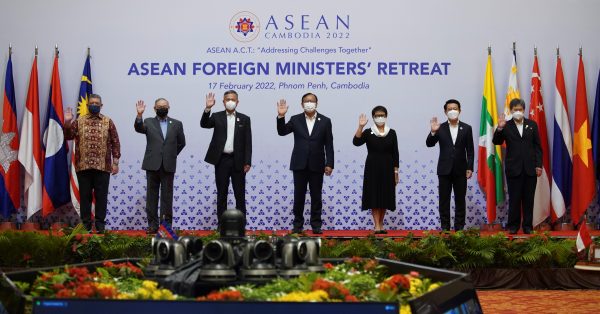It is important that ASEAN follows this track, especially as Phnom Penh’s priorities build on ASEAN’s previous initiatives to bring important deliverables in strengthening the ASEAN Economic Community (AEC).
ASEAN member states showed good results in their post-COVID-19 economic recovery. According to ASEAN data, the association’s nominal GDP in 2021 surpassed its pre-pandemic levels and reached US$3.3 trillion, while in 2022 it is projected to grow by 5 per cent. This prognosis is echoed by both the Asian Development Bank and the IMF’s outlooks.
ASEAN in 2022 further underscored that recovery should be people-centred and climate-resilient. The member states decided to prolong the validity of the Memorandum of Understanding on the Implementation of Non-Tariff Measures on Essential Goods until November 2024. This document, adopted in 2020, ensured the unhampered flow of agricultural and food products, as well as goods relating to the manufacture and distribution of vaccines, medicines, medical supplies and equipment. It now consists of 351 tariff lines (up from 152 initially).
Reflecting the considerable share of tourism in ASEAN economies, the association adopted several documents aimed at facilitating mutual recognition arrangements for industry professionals and the development of sustainable tourism.
In 2021 ASEAN’s trade in goods reached US$3.34 trillion, up from US$2.67 trillion in 2020, and FDI inflows into ASEAN jumped to US$174.1 billion from US$122.4 billion in 2020. But to stay relevant amid global supply chain disruptions, technological shifts and climate challenges, ASEAN needs to modernise its policy arrangements.
In March, negotiations were launched for upgrading the ASEAN Trade in Goods Agreement. Since trade liberalisation is arguably the most visible achievement of the AEC — duties for 98.6 per cent of tariff lines were eliminated — further efforts in this sphere are crucial. The agreement notably plans to include provisions surrounding paperless trade, the digital and circular economy and sustainable development.
ASEAN is also working on upgrading free trade agreements (FTAs) with its dialogue partners. A positive result is the conclusion of negotiations for the ASEAN–Australia–New Zealand FTA to make it more business-friendly. It improves transparency measures, lowers costs and time for trade, includes digital technology and education services and smooths the flow of essential goods during crises. Chapters encouraging the increased participation of micro, small, and medium enterprises (MSMEs) in economic activities — including government procurement —and trade and sustainable development were also added.
Another achievement is the launch of negotiations for upgrading the ASEAN–China Free Trade Area, ASEAN’s oldest FTA with its dialogue partners. It should become more future-oriented by including the digital and green economy, supply chain connectivity, competition, consumer protection and support for MSMEs. Considering the volume of trade and investment between China and ASEAN (trade with China amounts for 20 per cent of the overall association’s turnover), the results will be important for both sides. Big hopes in the region for the post-pandemic recovery and inclusive development are placed on the Regional Comprehensive Economic Partnership (RCEP), which entered into force on 1 January 2022. As was discussed during summits, the key issue is to encourage businesses to utilise the RCEP agreement, as well as to ensure greater trade efficiency among ASEAN members.
Connectivity was highlighted through a leaders’ statement on the post-2025 regional connectivity agenda. The idea is to take a comprehensive, cross-sectoral approach to promote people-to-people exchanges, innovation and industrial transformation, MSMEs and female entrepreneurship. It also aims to bridge gaps in development.
Due to changing political and economic landscapes, experts were anticipating further developments with the ASEAN Outlook on the Indo-Pacific (AOIP), particularly regarding the role of the association’s external partners. This document is often considered ASEAN’s attempt to propose a new architecture of regional cooperation while preserving its collective leadership.
But from the leaders’ declaration, it is hard to find what has been ‘mainstreamed’ in the Outlook. It is external partners who are ‘encouraged’ to expedite the implementation of AOIP by proposing practical and tangible projects or placing existing initiatives under the Outlook’s umbrella, as Japan and Australia did. It remains to be seen whether such an approach will support ASEAN centrality.
Assessments of the recent ASEAN summits vary from highly complimentary to sceptical, which raises questions about the possibilities of ASEAN moving beyond a get-together of global leaders. The region’s future is far from unclouded. Geopolitical tensions, monetary policy tightening in advanced economies and rising food and energy prices made the ADB lower its 2022 and 2023 forecasts of economic growth for developing Asian countries.
Although Cambodia sustained a good pace of economic growth during its chairmanship, ASEAN needs to speed up its collective efforts in creating a single market and production base, to maintain its competitiveness and attract FDI. In the longer-term, these efforts will be important for ASEAN maintaining centrality in advancing the region’s economic growth and integration.
Stepan Golovin is a Research Fellow at the Institute of World Economy and International Relations (IMEMO), Russian Academy of Social Sciences, Moscow.

